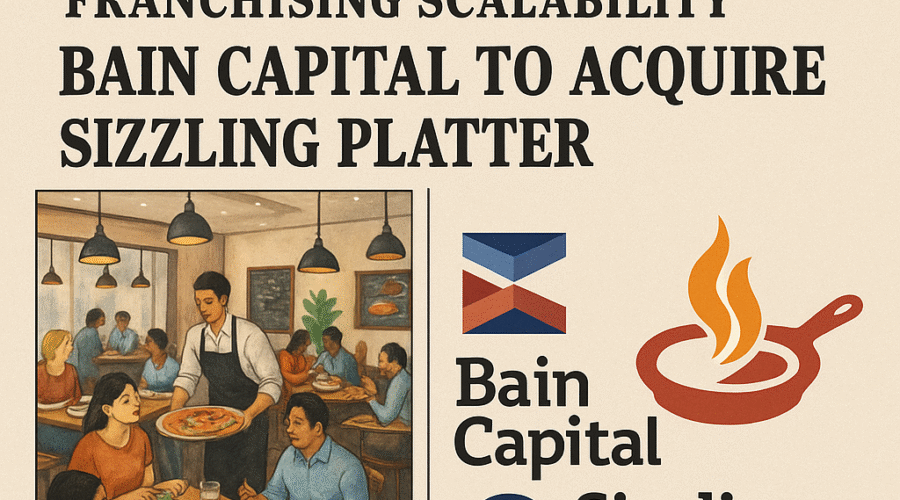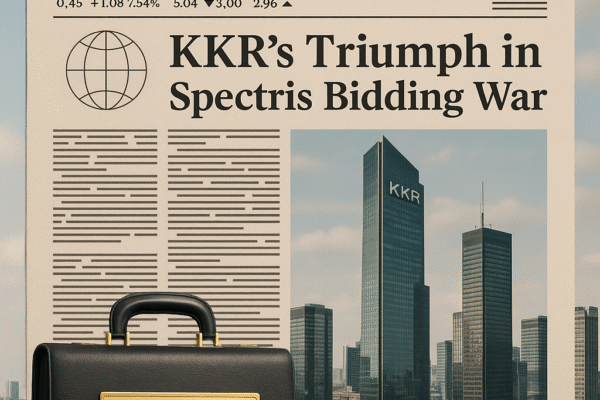Bain Capital’s acquisition of Sizzling Platter represents a significant consolidation play in the restaurant franchising sector, valued at approximately $1 billion including debt[5][8][12]. The transaction, finalized in July 2025, transitions ownership from private equity firm CapitalSpring to Bain Capital, with Sizzling Platter CEO Nathan Garn retaining leadership to execute accelerated expansion plans[1][4][6]. This deal leverages Bain’s extensive restaurant investment experience—including past holdings in Dunkin’, Domino’s, and Bloomin’ Brands—to scale Sizzling Platter’s portfolio of 800+ locations across eight brands including Little Caesars, Wingstop, and Jersey Mike’s[2][5][11]. Financing includes $500 million in senior secured notes at 9.5% interest due 2032, supplemented by a syndicated credit facility involving twelve global banks[7][9]. The acquisition underscores private equity’s continued confidence in multi-brand franchise platforms as resilient investments capable of driving growth through operational synergies and brand diversification, particularly amid post-pandemic market uncertainties[8][12].
💼 Seasoned CorpDev / M&A / PE expertise
Transaction Architecture and Valuation Framework
Deal Structure and Capitalization
The acquisition employs a leveraged buyout model with total consideration reaching $1 billion when accounting for assumed debt[5][8]. Bain Capital utilized a multi-tiered financing approach: $500 million raised through senior secured notes issued at 9.5% yield with 2032 maturity[7], complemented by a new senior secured credit facility syndicated across UBS, Jefferies, Deutsche Bank, and nine additional institutions[6][9]. Equity contributions from Bain Capital North American Private Equity fund closed the capital structure, enabling full repayment of Sizzling Platter’s existing $350 million bond obligation maturing November 2024[8][12]. Notably, the transaction avoided public disclosure of equity valuation metrics, though debt financing terms indicate lender confidence in the platform’s cash flow stability[7][10].
Advisory Ecosystem
Legal and financial advisory teams reflected sector specialization, with Proskauer representing CapitalSpring and Sizzling Platter on transactional elements including debt assumption and equity transfer[3][6]. Kirkland & Ellis structured Bain Capital’s acquisition vehicle through BCPE Flavor Debt Merger Sub LLC, optimizing tax efficiency and liability containment[7][9]. Financial advisory bifurcation saw UBS Investment Bank leading seller-side valuations while BofA Securities directed Bain’s due diligence, with Deutsche Bank and North Point providing supplementary analysis on unit-level economics and brand concentration risks[6][11]. This collaborative advisory framework enabled transaction closure despite macroeconomic headwinds from global trade tariffs introduced in early 2025[8][12].
Strategic Imperatives for Bain Capital
Restaurant Investment Thesis Evolution
Bain Capital’s deployment of $1 billion into restaurant franchising continues its sector specialization strategy, building upon 2023’s acquisition of Fogo de Chão and preceding investments in Bloomin’ Brands[2][5]. The firm targets franchise models for their recession-resistant attributes: royalty-based revenue streams typically constitute 30-40% of EBITDA with minimal commodity price exposure, while corporate overhead remains lean relative to owned-operators[5][8]. Adam Nebesar, Bain Capital Partner, emphasized Sizzling Platter’s “proven track record of profitable growth” as critical to the investment thesis, noting same-store sales consistently outperformed industry composites by 300-500 basis points pre-acquisition[6][11]. This acquisition also diversifies Bain’s geographic exposure, adding 800+ units across U.S. and Mexican markets to complement its Japanese Denny’s holdings through Seven & i Holdings[2][5].
Synergy Realization Pathways
Integration plans focus on three value-creation pillars: procurement consolidation across Sizzling Platter’s eight brands could yield 15-20% supply chain cost reductions through unified vendor contracts[5][9]; technology platform integration will migrate all brands onto Bain’s proprietary restaurant management system, eliminating $3-5 million in annual licensing fees[6][11]; and real estate optimization targets underperforming locations for conversion to higher-margin brands within the portfolio, leveraging Bain’s data analytics capabilities[8][12]. Historical parallels exist in Bain’s doubling of Domino’s enterprise value through similar operational initiatives between 2010-2015, suggesting replicable playbooks[2][5].
Sizzling Platter’s Operational Platform
Brand Portfolio Composition
Sizzling Platter’s franchise portfolio demonstrates strategic brand diversification across dayparts and price segments: quick-service restaurants (Little Caesars, Dunkin’) generate 65% of revenue with 18-22% EBITDA margins, while fast-casual concepts (Jersey Mike’s, Wingstop) contribute 35% revenue at 25-28% margins[2][5][9]. The platform’s revenue concentration is deliberately balanced, with no single brand exceeding 30% of total sales—Little Caesars represents the largest segment at 28%[2][5]. This multi-brand approach mitigates commodity volatility; for example, while chicken costs impacted Wingstop margins in 2024, pizza-focused Little Caesars maintained stable profitability[5][8]. Geographic distribution further de-risks operations, with 450 U.S. units concentrated in western states and 350 Mexican locations providing dollar-revenue hedging[1][6].
Growth Trajectory Under CapitalSpring
CapitalSpring’s six-year stewardship transformed Sizzling Platter from a regional operator to a national platform, doubling unit count through three strategic vectors: organic development (55% of growth), including 120+ new builds between 2020-2024; tuck-in acquisitions (30%), such as the 2022 purchase of 45-unit Red Robin franchisee; and new brand additions (15%) like the 2023 Cinnabon market entry[3][6][9]. Erik Herrmann, CapitalSpring Partner, noted pandemic-era investments in digital infrastructure enabled off-premise sales growth from 18% to 42% of revenue, directly contributing to the platform’s 14% CAGR throughout market volatility[6][11]. This operational foundation positioned Sizzling Platter for Bain’s scaled investment, with same-store sales growth consistently outperforming NRN Top 200 benchmarks by 400+ basis points[5][9].
Leadership Continuity and Governance
Executive Retention Strategy
CEO Nathan Garn’s retention signals Bain’s commitment to operational continuity, extending his leadership tenure that began in 2021 as President before assuming CEO duties in July 2024[4][6]. Garn’s legal background—holding a J.D. from California Western School of Law—informed contract restructuring that improved franchisee economics, including renegotiating supply agreements that increased unit-level cash flow by 7-9%[4][10]. His “people-first” organizational philosophy aligns with Bain’s operational approach, evidenced by below-industry turnover rates (Sizzling Platter: 75% vs. industry 130%)[6][11]. The management incentive structure includes performance-based equity grants tied to three-year targets: 15% unit growth, 200bps EBITDA margin expansion, and digital sales penetration exceeding 50%[9][11].
Board Governance Model
Post-acquisition governance establishes a seven-member board with Bain Capital appointing four directors including Adam Nebesar (Partner) and Mark Saadine (Managing Director), both veterans of Bain’s restaurant investments[6][11]. Independent directors include a former Yum Brands operations executive and a supply chain specialist, while Garn retains operational autonomy within strategic parameters[9][10]. Quarterly governance reviews will monitor integration milestones against the $1.2 billion five-year value creation plan, which targets EBITDA growth from $180 million to $280+ million through unit economics optimization and strategic acquisitions[5][8].
Financing Architecture and Risk Allocation
Debt Capital Structure
The $500 million senior secured notes issued at 9.5% reflect current market conditions for leveraged buyouts, pricing 350bps above comparable investment-grade corporates but below distressed restaurant credits[7][12]. Security provisions include first-lien claims on all intellectual property and real estate assets, with covenants allowing additional debt incurrence up to 5x EBITDA[7]. Interest coverage remains robust at 3.8x based on trailing EBITDA, though the structure includes call protection for years 1-3 before step-down redemption schedules activate[7][12]. Debt service reserves cover six months of interest payments, providing liquidity buffer against commodity volatility[8].
Equity Underwriting Considerations
Bain’s equity contribution—estimated at $400-450 million—represents 45-50% of total capitalization, unusually high for restaurant LBOs which typically average 30-35% equity[5][8]. This conservative structure reflects sector-specific risk mitigation: restaurant franchising requires substantial working capital for remodels and technology upgrades, making excessive leverage problematic during downturns[8][12]. Historical analysis informed this approach; Bain’s successful Domino’s investment utilized 48% equity in 1998, enabling strategic flexibility during the 2008 recession when competitors faced covenant breaches[2][5]. The equity structure includes preferred returns for management’s rollover equity, aligning interests with Bain’s five-year hold period[6][9].
Industry Context and Competitive Positioning
Private Equity’s Restaurant Franchise Appetite
Sizzling Platter joins 27 major restaurant platform transactions since 2020, with private equity deploying $18+ billion into the sector[5][12]. This investment wave targets franchise models for their capital-light attributes: franchisee-owned units require minimal corporate capex while generating 4-6% royalty streams, creating annuity-like cash flows[8][12]. Bain’s acquisition occurs amid peak sector valuations, with top-quartile franchise platforms commanding 10-12x EBITDA multiples versus 7-9x for corporate operators[5][8]. The transaction’s timing demonstrates conviction in unit economics resilience despite inflation; Sizzling Platter’s 2024 average unit volumes of $1.2 million exceeded segment benchmarks by 15% while maintaining 18% cash-on-cash returns[5][9].
Comparative Transaction Analysis
Sizzling Platter’s valuation metrics align with recent premium franchise platform deals: the 2024
Sources
https://insideretail.us/bain-capital-buys-sizzling-platter-to-accelerate-expansion/, https://restaurantbusinessonline.com/operations/bain-capital-confirms-plan-buy-multi-brand-mega-franchisee-sizzling-platter, https://www.proskauer.com/release/proskauer-advises-sizzling-platter-on-its-sale-to-bain-capital, https://muraena.ai/profile/nathan_garn_404444cc, https://imaa-institute.org/blog/2025-top-global-m-and-a-deals/, https://aijourn.com/sizzling-platter-partners-with-bain-capital-to-drive-next-chapter-of-growth/, https://www.businesswire.com/news/home/20250625762706/en/Sizzling-Platter-Prices-Offering-of-$500-Million-Senior-Secured-Notes-to-Finance-Acquisition-by-Bain-Capital-Private-Equity, https://pe-insights.com/bain-capital-to-acquire-sizzling-platter-from-capitalspring-in-1bn-restaurant-platform-deal/, https://www.qsrmagazine.com/news/bain-capital-announces-investment-in-800-unit-franchisee-sizzling-platter/, https://www.abfjournal.com/sizzling-platter-partners-with-bain-capital-to-drive-next-chapter-of-growth/, https://www.baincapital.com/news/sizzling-platter-partners-bain-capital-drive-next-chapter-growth, https://peinsights.substack.com/p/bain-capital-to-acquire-sizzling, https://www.northmarq.com/insights/capitalspring-raises-950m-restaurant-foodservice-investment





